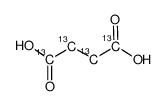Succinic acid-13C4
Modify Date: 2024-01-10 12:24:53

Succinic acid-13C4 structure
|
Common Name | Succinic acid-13C4 | ||
|---|---|---|---|---|
| CAS Number | 201595-67-7 | Molecular Weight | 122.05900 | |
| Density | 1.408g/cm3 | Boiling Point | 235ºC | |
| Molecular Formula | C4H6O4 | Melting Point | 187-190ºC(lit.) | |
| MSDS | Chinese USA | Flash Point | N/A | |
| Symbol |


GHS05, GHS07 |
Signal Word | Danger | |
Use of Succinic acid-13C4Succinic acid-13C4 is the 13C labeled Succinic acid[1]. Succinic acid is a potent and orally active anxiolytic agent. Succinic acid is an intermediate product of the tricarboxylic acid cycle. Succinic acid can be used as a precursor of many industrially important chemicals in food, chemical and pharmaceutical industries[2][3]. |
| Name | Succinic acid-13C4 |
|---|---|
| Synonym | More Synonyms |
| Description | Succinic acid-13C4 is the 13C labeled Succinic acid[1]. Succinic acid is a potent and orally active anxiolytic agent. Succinic acid is an intermediate product of the tricarboxylic acid cycle. Succinic acid can be used as a precursor of many industrially important chemicals in food, chemical and pharmaceutical industries[2][3]. |
|---|---|
| Related Catalog | |
| In Vitro | Stable heavy isotopes of hydrogen, carbon, and other elements have been incorporated into drug molecules, largely as tracers for quantitation during the drug development process. Deuteration has gained attention because of its potential to affect the pharmacokinetic and metabolic profiles of drugs[1]. |
| References |
[4]. Si Wei Chen, Anxiolytic-like effect of succinic acid in mice. Life Sci. 2003 Nov 773(25):3257-64. |
| Density | 1.408g/cm3 |
|---|---|
| Boiling Point | 235ºC |
| Melting Point | 187-190ºC(lit.) |
| Molecular Formula | C4H6O4 |
| Molecular Weight | 122.05900 |
| Exact Mass | 122.04000 |
| PSA | 74.60000 |
| Index of Refraction | 1.477 |
| Symbol |


GHS05, GHS07 |
|---|---|
| Signal Word | Danger |
| Hazard Statements | H315-H318-H335 |
| Precautionary Statements | P261-P280-P305 + P351 + P338 |
| Hazard Codes | Xi |
| Risk Phrases | R36/37/38 |
| Safety Phrases | 26-36 |
| RIDADR | NONH for all modes of transport |
|
Metabolomics study of hepatocellular carcinoma: discovery and validation of serum potential biomarkers by using capillary electrophoresis-mass spectrometry.
J. Proteome Res. 13(7) , 3420-31, (2014) Hepatocellular carcinoma (HCC) is one of the most lethal malignancies. The lack of effective screening methods for early diagnosis has been a longstanding bottleneck to improve the survival rate. In t... |
| Yantar-antitox-13C4 |
| Dihydrofumaric Acid-13C4 |
| Amber Acid-13C4 |
| 1,4-Butanedioic Acid-13C4 |
| MFCD00145335 |
| Butanedioic acid-13C4 |
| Katasuccin-13C4 |
| Wormwood Acid-13C4 |
| Asuccin-13C4 |